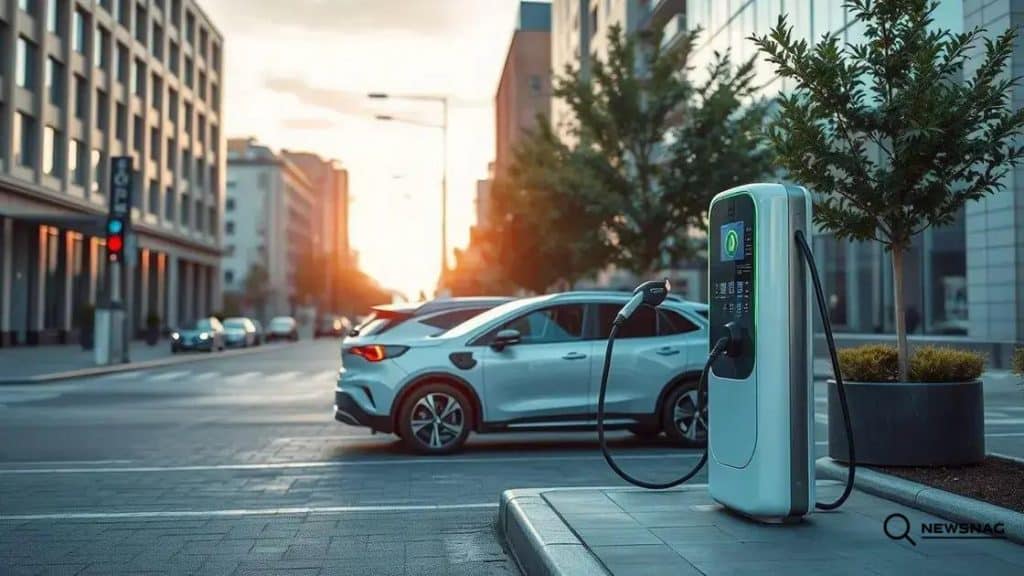Electric vehicle infrastructure: your guide to the future

Anúncios
The future of battery-powered transport is driven by advancements in battery technologies, expanding charging infrastructure, and the integration of renewable energy, all contributing to a more sustainable and efficient transportation system.
Electric vehicle infrastructure is rapidly transforming the way we think about transportation. With the rise of battery-powered vehicles, preparing for this shift is more important than ever. Are you ready to embrace a cleaner, more efficient future?
Anúncios
Understanding electric vehicle infrastructure
Understanding electric vehicle infrastructure is crucial as we transition toward a more sustainable future. It involves various components necessary to support the growing number of electric vehicles (EVs) on our roads. This infrastructure not only includes charging stations but also the technology and planning required to ensure these systems work seamlessly.
Key Components
At the heart of electric vehicle infrastructure are the charging stations. These facilities are essential for EV owners, providing the means to recharge their vehicles efficiently. However, there is more to consider.
Charging Station Types
- Level 1 Charging: Standard household outlets, suitable for overnight charging but slower.
- Level 2 Charging: Commonly found in public areas, these stations charge vehicles more quickly.
- DC Fast Charging: Rapid charging stations ideal for long trips, significantly reducing downtime.
In addition to charging stations, the layout of power grids is also vital. Upgrading the grid is necessary to handle additional electricity demand from EVs. Furthermore, integrating renewable energy sources can enhance sustainability, powering charging stations with green energy. Smart technology, including apps and payment systems, offers convenience for users. These innovations ensure that finding and using charging stations is straightforward.
Anúncios
Moreover, government policies play a significant role in expanding electric vehicle infrastructure. Incentives for building more stations and regulations that support standardization can accelerate adoption. Public-private partnerships can drive investment and innovation, leading to more efficient solutions.
Community engagement is also essential. Educating the public about the benefits of EVs and having accessible information about where to charge can foster acceptance and encourage more drivers to make the switch.
Key components of charging stations
Key components of charging stations play a vital role in the success of electric vehicle infrastructure. Understanding these elements helps us see how charging stations can efficiently serve drivers.
Charging Equipment
At the core of each station is the charging equipment, which includes the plug and wiring necessary to deliver power to electric vehicles. Different types of chargers, such as Level 2 and DC Fast Chargers, serve distinct needs. Level 2 chargers are popular for home use, while DC Fast Chargers provide rapid charging, making them ideal for public stations.
Power Source
A charging station needs a reliable power source to operate effectively. This involves connecting to the grid, which may require upgrading existing infrastructure to handle increased electricity demands. Some stations utilize renewable energy sources, such as solar panels, to provide a sustainable charging solution.
User Interface
The user interface is another essential component. It allows drivers to interact with the charging station easily. Features may include touch screens, payment options, and real-time information about charging status. Clear signage is also important for guiding users on how to start and stop the charging process.
- Accessibility: Charging stations should be easily accessible for all EV users, providing convenience and promoting adoption.
- Location: Strategically placing charging stations in high-traffic areas can maximize usage and reduce range anxiety.
- Maintenance: Regular maintenance is crucial to ensure charging stations operate smoothly and efficiently.
Moreover, charging stations often incorporate smart technology that allows for remote monitoring. This capability not only helps in managing energy consumption but also provides data that can inform future infrastructure planning. Investing in smart grid technology is essential as it enhances the efficiency of electrical distribution, making charging stations more reliable.
Safety features are also critical. These may include grounding systems, surge protection, and emergency shut-off switches. Ensuring safety helps promote public confidence in using electric vehicle charging stations.
Benefits of robust charging networks

Robust charging networks offer numerous benefits that significantly contribute to the growth of electric vehicle infrastructure. These benefits extend beyond just convenience and play a key role in promoting the adoption of electric vehicles (EVs).
Enhanced Accessibility
Having a widespread charging network ensures that EV owners can find charging stations easily. This accessibility reduces range anxiety, which is a major concern for potential EV buyers. When drivers know they have reliable access to chargers, they are more likely to switch to electric vehicles.
Supporting Long-Distance Travel
Robust charging networks enable long-distance travel for EV users. With strategically placed rapid charging stations, drivers can embark on road trips without worrying about running out of power. This capability can make EVs a viable alternative to traditional vehicles for traveling between cities.
- Convenient Locations: Charging stations should be located near restaurants, shopping areas, and rest stops, providing drivers the ability to charge while taking breaks.
- Faster Charging Options: Having a variety of charging speeds allows users to recharge according to their needs, making travel more efficient.
- Multiple Payment Methods: Offering various payment options simplifies the process and encourages more people to use EVs.
Additionally, a robust network can lead to economic benefits. As EV adoption grows, so does the demand for charging stations. This demand can create job opportunities in several sectors, including construction, maintenance, and technology. Moreover, businesses that provide charging options can attract more customers, boosting sales.
Furthermore, investing in a strong charging network supports the transition to renewable energy. Many charging stations are now being equipped with solar panels or connected to renewable energy sources. This shift not only promotes sustainability but also helps reduce the carbon footprint associated with traditional fuel sources.
Finally, a robust charging network enhances the overall experience for EV drivers, fostering a community of sustainable practice. Encouraging education and awareness about EV technology and charging infrastructure can further amplify these benefits.
Challenges in building EV infrastructure
Building EV infrastructure presents several challenges that must be addressed to support the growing number of electric vehicles on the road today. Understanding these obstacles is crucial for developing effective solutions.
High Installation Costs
One of the main challenges is the high cost of installing charging stations. This includes expenses for the hardware, installation labor, and necessary upgrades to electrical systems. Many businesses and local governments often hesitate to invest heavily when the return on investment is uncertain.
Electric Grid Limitations
The existing electrical grid can also pose problems. In many areas, the grid is not equipped to handle the increased demand from multiple charging stations. Upgrading the grid requires significant investment and coordination among different stakeholders, making it a complex process.
Lack of Standardization
Another challenge is the lack of standardization in charging technology. Different EV manufacturers use various connectors and charging protocols. This inconsistency can confuse consumers and hinder the development of a cohesive charging network.
- Competing Technologies: Different technologies can lead to fragmentation in the market, making it harder for users to find compatible chargers.
- Market Competition: Companies may compete on several fronts, affecting the growth of a unified charging infrastructure.
- Consumer Education: Many drivers are still unaware of the benefits and availability of EV infrastructure, which can slow down adoption.
In addition, urban planning poses its own challenges. Many cities have limited space for new charging stations, particularly in dense areas. This makes it difficult to place chargers where they are most needed. Collaborating with local governments and urban planners is essential to identify suitable locations.
Furthermore, public perception can impede progress. Some individuals are still skeptical about switching to electric vehicles. Addressing myths and providing clear information on the benefits of EV infrastructure will help foster acceptance. Community outreach and education campaigns can be pivotal in changing these perceptions.
Lastly, policies and regulations must evolve to support the growing demand for charging stations. Governments play a key role in shaping the infrastructure landscape by providing incentives for installations and creating regulatory frameworks that encourage investment.
The future of battery-powered transport
The future of battery-powered transport is bright and full of potential. As technology advances, we are likely to see exciting developments that will transform how we think about transportation.
Innovative Battery Technologies
The evolution of battery technologies will play a crucial role in shaping the future. New materials, such as solid-state batteries, promise to offer higher energy density and faster charging times. These improvements will make electric vehicles (EVs) more efficient and attractive to consumers. Car manufacturers are heavily investing in research and development to bring these technologies to market.
Expansion of Charging Infrastructure
As battery-powered transport becomes more mainstream, a robust charging infrastructure will be essential. Governments and private companies are working together to build more charging stations in urban and rural areas. This expansion will reduce range anxiety and encourage more people to choose electric vehicles.
- Fast-Charging Technology: The development of ultra-fast charging stations will significantly reduce downtime for EV users, making travel more convenient.
- Wireless Charging: Future technologies might allow for wireless charging on the go, such as embedded charging lanes on highways.
- Sustainable Energy Sources: Integrating renewable energy sources to power charging stations will enhance sustainability.
Moreover, we can expect advancements in smart technologies that align with battery-powered transport. Features such as real-time data analytics will optimize energy use and maintenance for vehicles and charging stations. The rise of smart grids will facilitate the seamless distribution of energy, allowing for more efficient usage during peak and off-peak times.
The shift toward battery-powered transport will also promote innovations in public transportation. Electric buses and trains are already making an impact, and future developments could lead to even more environmentally friendly options. Cities will benefit from cleaner air and less noise pollution as more electric vehicles hit the roads.
Finally, public policy will play a significant role in this transition. Supportive regulations, incentives for manufacturing, and the adoption of electric vehicles will encourage their widespread use. Awareness campaigns will further inform the public about the benefits of battery-powered transport, making the transition smoother.
In conclusion, the future of battery-powered transport is filled with opportunities that can transform our way of life. Advancements in battery technology, coupled with a robust charging infrastructure, will make electric vehicles more accessible and convenient. As we continue to innovate, we can expect sustainable public transportation options to emerge, reducing our reliance on fossil fuels. It is essential for governments, businesses, and communities to work together to create a supportive environment for this transition. With their combined efforts, we can pave the way toward a cleaner, greener future for all.
FAQ – Frequently Asked Questions about Battery-Powered Transport
What are the main benefits of battery-powered transport?
Battery-powered transport offers reduced emissions, improved air quality, and lower operating costs, making it an eco-friendly choice.
How is the charging infrastructure evolving?
Charging infrastructure is expanding rapidly, with more stations being installed and advancements in fast-charging technology enhancing user convenience.
What future technologies are expected in electric vehicles?
Innovations like solid-state batteries, wireless charging, and smart grid integration are expected to make electric vehicles more efficient and user-friendly.
How can governments support the transition to battery-powered transport?
Governments can support this transition by providing incentives, investing in infrastructure, and implementing policies that promote electric vehicles.





